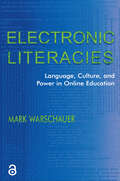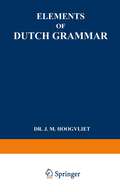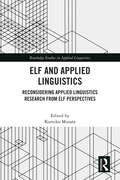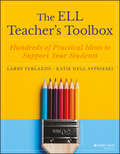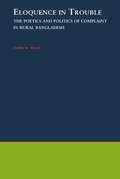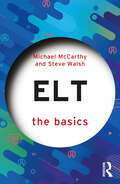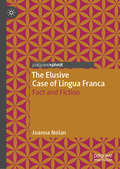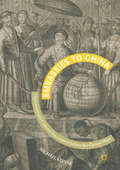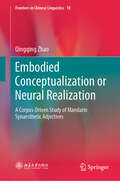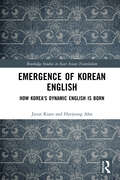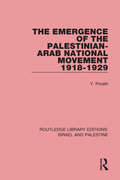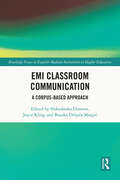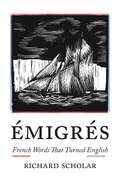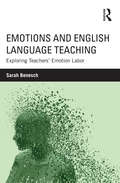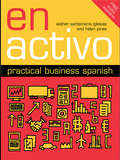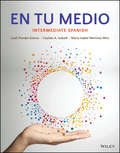- Table View
- List View
Electronic Literacies: Language, Culture, and Power in Online Education
by Mark WarschauerElectronic Literacies is an insightful study of the challenges and contradictions that arise as culturally and linguistically diverse learners engage in new language and literacy practices in online environments. The role of the Internet in changing literacy and education has been a topic of much speculation, but very little concrete research. This book is one of the first attempts to document the role of the Internet and other new digital technologies in the development of language and literacy. Warschauer looks at how the nature of reading and writing is changing, and how those changes are being addressed in the classroom. His focus is on the experiences of culturally and linguistically diverse learners who are at special risk of being marginalized from the information society. Based on a two-year ethnographic study of the uses of the Internet in four language and writing classrooms in the state of Hawai'i--a Hawaiian language class of Native Hawaiian students seeking to revitalize their language and culture; an ESL class of students from Pacific Island and Latin American countries; an ESL class of students from Asian countries; and an English composition class of working-class students from diverse ethnic backgrounds--the book includes data from interviews with students and teachers, classroom observations, and analysis of student texts. This rich ethnographic data is combined with theories from a broad range of disciplines to develop conclusions about the relationship of technology to language, literacy, education, and culture. Central to Warschauer's discussion and conclusions is how contradictions of language, culture, and class affect the impact of Internet-based education. While Hawai'i is a special place, the issues confronted here are similar in many ways to those that exist throughout the United States and many other countries: How to provide culturally and linguistically diverse students traditionally on the educational and technological margins with the literacies they need to fully participate in public, community, and economic life in the 21st century.
ELF and Applied Linguistics: Reconsidering Applied Linguistics Research from ELF Perspectives (Routledge Studies in Applied Linguistics)
by Kumiko MurataWith help from a global cast of scholars, Kumiko Murata explores the remodelling of the discipline of applied linguistics, which traditionally regarded Anglophone native-speaker English as the standard for English as a lingua franca (ELF).This edited volume probes the dichotomy between the current focus of applied linguistic research and a drastically changed English use in a globalised world. This division is approached from diverse perspectives and with the overarching understanding of ELF as an indispensable area of applied linguistics research. The volume includes theoretical backgrounds to English as a lingua franca, the nature of ELF interactions, language policy and practice from an ELF perspective, and the relationship between multilingualism and ELF.A resourceful book not only to ELF researchers but also applied linguists in general, as well as policy makers, administrators, practicing teachers, and university students from diverse linguacultural backgrounds.
ELF and Applied Linguistics: Reconsidering Applied Linguistics Research from ELF Perspectives (Routledge Studies in Applied Linguistics)
by Kumiko MurataWith help from a global cast of scholars, Kumiko Murata explores the remodelling of the discipline of applied linguistics, which traditionally regarded Anglophone native-speaker English as the standard for English as a lingua franca (ELF).This edited volume probes the dichotomy between the current focus of applied linguistic research and a drastically changed English use in a globalised world. This division is approached from diverse perspectives and with the overarching understanding of ELF as an indispensable area of applied linguistics research. The volume includes theoretical backgrounds to English as a lingua franca, the nature of ELF interactions, language policy and practice from an ELF perspective, and the relationship between multilingualism and ELF.A resourceful book not only to ELF researchers but also applied linguists in general, as well as policy makers, administrators, practicing teachers, and university students from diverse linguacultural backgrounds.
The ELL Teacher's Toolbox: Hundreds of Practical Ideas to Support Your Students (The Teacher's Toolbox Series)
by Larry Ferlazzo Katie Hull SypnieskiPractical strategies to support your English language learners The ELL Teacher’s Toolbox is a practical, valuable resource to be used by teachers of English Language Learners, in teacher education credential programs, and by staff development professionals and coaches. It provides hundreds of innovative and research-based instructional strategies you can use to support all levels of English Language Learners. Written by proven authors in the field, the book is divided into two main sections: Reading/Writing and Speaking/Listening. Each of those sections includes “Top Ten” favorites and between 40 and 70 strategies that can be used as part of multiple lessons and across content areas. Contains 60% new strategies Features ready-to-use lesson plans Includes reproducible handouts Offers technology integration ideas The percentage of public school students in the U.S. who are English language learners grows each year—and with this book, you’ll get a ton of fresh, innovative strategies to add to your teaching arsenal.
The ELL Teacher's Toolbox: Hundreds of Practical Ideas to Support Your Students (The Teacher's Toolbox Series)
by Larry Ferlazzo Katie Hull SypnieskiPractical strategies to support your English language learners The ELL Teacher’s Toolbox is a practical, valuable resource to be used by teachers of English Language Learners, in teacher education credential programs, and by staff development professionals and coaches. It provides hundreds of innovative and research-based instructional strategies you can use to support all levels of English Language Learners. Written by proven authors in the field, the book is divided into two main sections: Reading/Writing and Speaking/Listening. Each of those sections includes “Top Ten” favorites and between 40 and 70 strategies that can be used as part of multiple lessons and across content areas. Contains 60% new strategies Features ready-to-use lesson plans Includes reproducible handouts Offers technology integration ideas The percentage of public school students in the U.S. who are English language learners grows each year—and with this book, you’ll get a ton of fresh, innovative strategies to add to your teaching arsenal.
Eloquence in Trouble: The Poetics and Politics of Complaint in Rural Bangladesh (Oxford Studies in Anthropological Linguistics)
by James M. WilceEloquence in Trouble captures the articulation of several troubled lives in Bangladesh as well as the threats to the very genres of their expression, lament in particular. The first ethnography of one of the most spoken mother tongues on earth, Bangla, this study represents a new approach to troubles talk, combining the rigor of discourse analysis with the interpretive depth of psychological anthropology. Its careful transcriptions of Bangladeshi troubles talk will disturb some readers and move others--beyond past academic discussion of personhood in South Asia.
ELT: The Basics (The Basics)
by Michael McCarthy Steve WalshELT: The Basics offers a clear, non-jargonistic introduction to English language teaching for EFL/ESL teachers in training, early career teachers, those considering taking up ELT, and experienced teachers who may want to read about the way the profession has developed and continues to evolve. Key features of this book include: Real classroom data and data from ELT training programmes Discussion of a wide range of learning contexts and different types of learners (young learners, adults, third age, academic, refugees and immigrants, etc.) Comparisons of different types of syllabuses and methods, and discussion of current technologies An emphasis on classroom interaction as the key to maximising learning Featuring a glossary of key terms, cartoons and illustrations, further reading, personal reflection points, and discussion of the most important and relevant research, this book is a clear and accessible introduction to the complex field of ELT.
ELT: The Basics (The Basics)
by Michael McCarthy Steve WalshELT: The Basics offers a clear, non-jargonistic introduction to English language teaching for EFL/ESL teachers in training, early career teachers, those considering taking up ELT, and experienced teachers who may want to read about the way the profession has developed and continues to evolve. Key features of this book include: Real classroom data and data from ELT training programmes Discussion of a wide range of learning contexts and different types of learners (young learners, adults, third age, academic, refugees and immigrants, etc.) Comparisons of different types of syllabuses and methods, and discussion of current technologies An emphasis on classroom interaction as the key to maximising learning Featuring a glossary of key terms, cartoons and illustrations, further reading, personal reflection points, and discussion of the most important and relevant research, this book is a clear and accessible introduction to the complex field of ELT.
The Elusive Case of Lingua Franca: Fact and Fiction
by Joanna NolanThis book explores many of the unanswered questions surrounding the original and eponymous Lingua Franca, a language spoken by peoples across the Mediterranean and North Africa for nearly three centuries. Allowing people from different countries, classes and cultures to interact with one another for the purposes of trade, piracy, slavery and diplomacy - among many other domains - Lingua Franca was lexified by Romance languages, including Italian and its dialects, Spanish, French and Portuguese, with possible Turkish and Arabic influences as well. The potential unreliability of source accounts, the blurring of fact and fiction across documentary and dramatic sources, and the linguistic biases and plurilingual repertoire of many of Lingua Franca’s speakers all combine to make Lingua Franca an elusive topic for examination. The author draws upon previously unexplored documentary evidence, including correspondence from the era found in The National Archives at Kew, to shed light on the multilingual and plurilingual landscape that fostered Lingua Franca’s development and spread, and its influence on the written domain. This book will be of interest to students and scholars of colonial history, linguistic anthropology, sociolinguistics and language contact.
Embassies to China: Diplomacy and Cultural Encounters Before the Opium Wars
by Michael KeevakThis text is a timely and wide-ranging study providing essential background to the development of global modernity through the European encounter with China. Considering differing notions of peace, empire, trade, religion, and diplomacy as touchstones in the relations between China and Europe on mutuality, the book examines five encounters with France, Portugal, Holland, the pope, and Russia between 1248 and 1720, and reflects on concepts that the West took for granted but which did not successfully cross over into the Chinese world. This cutting edge text provides key insights into the cultural and political conflict which lay at the heart of early Chinese-European relations, as the West's understanding of the truth and appropriateness of its cultural norms was confronted by China's norms and beliefs.
Embassies to China: Diplomacy and Cultural Encounters Before the Opium Wars
by Michael KeevakThis text is a timely and wide-ranging study providing essential background to the development of global modernity through the European encounter with China. Considering differing notions of peace, empire, trade, religion, and diplomacy as touchstones in the relations between China and Europe on mutuality, the book examines five encounters with France, Portugal, Holland, the pope, and Russia between 1248 and 1720, and reflects on concepts that the West took for granted but which did not successfully cross over into the Chinese world. This cutting edge text provides key insights into the cultural and political conflict which lay at the heart of early Chinese-European relations, as the West's understanding of the truth and appropriateness of its cultural norms was confronted by China's norms and beliefs.
Embodied Conceptualization or Neural Realization: A Corpus-Driven Study of Mandarin Synaesthetic Adjectives (Frontiers in Chinese Linguistics #10)
by Qingqing ZhaoThis book focuses on linguistic synaesthesia in a hitherto less-studied language – Mandarin Chinese – and adopts a corpus-driven approach to support the analysis and argumentation. The study identifies directional tendencies and underlying mechanisms for Mandarin synaesthetic adjectives. By doing so, it not only provides an added layer of understanding for theories of linguistic synaesthesia, but also offers evidence to help refine previous theories, such as Embodiment Theory and Conceptual Metaphor Theory. In brief, the book makes a significant contribution to the development of Cognitive Linguistics. The intended readership includes, but is not limited to, graduate students in linguistics and researchers interested in Chinese linguistics in particular, and in lexical semantics and cognitive linguistics in general.
Emergence of Korean English: How Korea's Dynamic English is Born (Routledge Studies in East Asian Translation)
by Jieun Kiaer Hyejeong AhnEmergence of Korean English explores the dynamic nature of emerging Korean English and its impact on Korean society, culture, and identity. This book challenges the negative stereotypes and stigmatization of Konglish and argues that it has been a great asset for Korea’s fast economic development. The fate of Korean English has been transformed in the time of the Korean wave as the K-fandom actively engages with Korean English. The book offers a comprehensive overview of Korea’s encounter with the English language and provides an in-depth analysis of linguistic characteristics, pragmatic features, and cross-cultural and cross-linguistic aspects of Korean English. The authors examine the unique linguistic features of Korean English, including phonological, syntactic, and lexical features, and highlight the sociocultural implications of these features for Korean society. In addition, the book discusses the role of Hallyu fandom languages in the emergence of Korean English and the growth of Korean pop culture worldwide. It also provides insights into the English fever in South Korea and its impact on education, society, and culture. This book is a valuable resource for scholars, students, and professionals who are interested in the emergence of Korean English and its social, cultural, and linguistic implications for Korea and the global community.
Emergence of Korean English: How Korea's Dynamic English is Born (Routledge Studies in East Asian Translation)
by Jieun Kiaer Hyejeong AhnEmergence of Korean English explores the dynamic nature of emerging Korean English and its impact on Korean society, culture, and identity. This book challenges the negative stereotypes and stigmatization of Konglish and argues that it has been a great asset for Korea’s fast economic development. The fate of Korean English has been transformed in the time of the Korean wave as the K-fandom actively engages with Korean English. The book offers a comprehensive overview of Korea’s encounter with the English language and provides an in-depth analysis of linguistic characteristics, pragmatic features, and cross-cultural and cross-linguistic aspects of Korean English. The authors examine the unique linguistic features of Korean English, including phonological, syntactic, and lexical features, and highlight the sociocultural implications of these features for Korean society. In addition, the book discusses the role of Hallyu fandom languages in the emergence of Korean English and the growth of Korean pop culture worldwide. It also provides insights into the English fever in South Korea and its impact on education, society, and culture. This book is a valuable resource for scholars, students, and professionals who are interested in the emergence of Korean English and its social, cultural, and linguistic implications for Korea and the global community.
The Emergence of the Palestinian-Arab National Movement, 1918-1929 (RLE Israel and Palestine)
by Yehoshua PorathThe resurgence of Palestinian nationalism in the wake of the 1967 Arab-Israeli war tended to overshadow the fact that Palestinian national consciousness is not a new phenomenon, but traces its origins back to the time when the first stirrings of nationalism were being felt in many parts of the under-developed world. This work, first published in 1974, is based on both Arabic and Hebrew primary sources as well as English and French official and unofficial documents, and was the first detailed study of the infancy period of Palestinian nationalism. The book begins by establishing the position of Palestine and Jerusalem in Islamic history and their significance within the concepts of Islam, and outlines the social and political features of the Palestinian population at the beginning of the First World War. The author then charts in detail the development of Palestinian nationalism over the decade after the War. Two major forces influenced this development and reacted with it: Zionism, with its ambitious schemes for settling Jews in Palestine and creating a National Home for them there, and Arab nationalism on a wider scale, which was emerging spontaneously with the disintegration of the Ottoman Empire and the spreading of ideas of self-determination. The growing threat posed by Zionism awoke the Palestinian population to the need for organization and the establishment of their own identity to oppose it, while the focus of their national aspirations widened or narrowed according to the ability which they felt at any given time to confront Zionism and achieve self-expression within a Palestinian rather than an all-Syrian national framework. The events of these turbulent years – the confrontations with the British, delegations, boycotts, proposals and rejections, the emergence of al-Hajj Amin al-Husayni, the Wailing Wall conflict and its repercussions – are all described within the context of these wider considerations, which also include Britain’s own role as holder of the Mandate over Palestine.
The Emergence of the Palestinian-Arab National Movement, 1918-1929 (RLE Israel and Palestine)
by Yehoshua PorathThe resurgence of Palestinian nationalism in the wake of the 1967 Arab-Israeli war tended to overshadow the fact that Palestinian national consciousness is not a new phenomenon, but traces its origins back to the time when the first stirrings of nationalism were being felt in many parts of the under-developed world. This work, first published in 1974, is based on both Arabic and Hebrew primary sources as well as English and French official and unofficial documents, and was the first detailed study of the infancy period of Palestinian nationalism. The book begins by establishing the position of Palestine and Jerusalem in Islamic history and their significance within the concepts of Islam, and outlines the social and political features of the Palestinian population at the beginning of the First World War. The author then charts in detail the development of Palestinian nationalism over the decade after the War. Two major forces influenced this development and reacted with it: Zionism, with its ambitious schemes for settling Jews in Palestine and creating a National Home for them there, and Arab nationalism on a wider scale, which was emerging spontaneously with the disintegration of the Ottoman Empire and the spreading of ideas of self-determination. The growing threat posed by Zionism awoke the Palestinian population to the need for organization and the establishment of their own identity to oppose it, while the focus of their national aspirations widened or narrowed according to the ability which they felt at any given time to confront Zionism and achieve self-expression within a Palestinian rather than an all-Syrian national framework. The events of these turbulent years – the confrontations with the British, delegations, boycotts, proposals and rejections, the emergence of al-Hajj Amin al-Husayni, the Wailing Wall conflict and its repercussions – are all described within the context of these wider considerations, which also include Britain’s own role as holder of the Mandate over Palestine.
EMI Classroom Communication: A Corpus-Based Approach (Routledge Focus on English-Medium Instruction in Higher Education)
by Slobodanka Dimova Joyce Kling Branka Drlja 269 A Margi 263Examining English medium instruction (EMI) through a corpus-based approach, this volume offers a critical inquiry into the use of different linguistic and pedagogical strategies in the EMI classroom. It explores aspects of content lecturers’ language use, pedagogy, and intercultural communicative competence by drawing on the findings obtained from EMI lecture corpus analysis and post-observation interviews with EMI lecturers from five universities in Croatia, Denmark, Italy, the Netherlands, and Spain. The book also offers insights into lecturers’ engagement with students in English, which is their second language, as well as their perception of differences between EMI and first-language-medium instruction (L1MI). Finally, the volume provides readers with corpus-based analysis of teachers’ oral ability profiles, as a basis for the identification of communicational challenges and provision of language support. The book will be of interest to scholars interested in EMI in higher education, and postgraduate students in applied linguistics and TESOL programs. It will also be relevant to teachers who are involved in EMI provision, teacher trainers who design support programs for EMI teachers, and policymakers who establish language-in-education policies for EMI.
EMI Classroom Communication: A Corpus-Based Approach (Routledge Focus on English-Medium Instruction in Higher Education)
by Slobodanka Dimova Joyce Kling Branka Drljača MargićExamining English medium instruction (EMI) through a corpus-based approach, this volume offers a critical inquiry into the use of different linguistic and pedagogical strategies in the EMI classroom. It explores aspects of content lecturers’ language use, pedagogy, and intercultural communicative competence by drawing on the findings obtained from EMI lecture corpus analysis and post-observation interviews with EMI lecturers from five universities in Croatia, Denmark, Italy, the Netherlands, and Spain. The book also offers insights into lecturers’ engagement with students in English, which is their second language, as well as their perception of differences between EMI and first-language-medium instruction (L1MI). Finally, the volume provides readers with corpus-based analysis of teachers’ oral ability profiles, as a basis for the identification of communicational challenges and provision of language support. The book will be of interest to scholars interested in EMI in higher education, and postgraduate students in applied linguistics and TESOL programs. It will also be relevant to teachers who are involved in EMI provision, teacher trainers who design support programs for EMI teachers, and policymakers who establish language-in-education policies for EMI.
Émigrés: French Words That Turned English
by Richard ScholarThe fascinating history of French words that have entered the English language and the fertile but fraught relationship between English- and French-speaking cultures across the world.English has borrowed more words from French than from any other modern foreign language. French words and phrases—such as à la mode, ennui, naïveté and caprice—lend English a certain je-ne-sais-quoi that would otherwise elude the language. Richard Scholar examines the continuing history of untranslated French words in English and asks what these words reveal about the fertile but fraught relationship that England and France have long shared and that now entangles English- and French-speaking cultures all over the world.Émigrés demonstrates that French borrowings have, over the centuries, “turned” English in more ways than one. From the seventeenth-century polymath John Evelyn’s complaint that English lacks “words that do so fully express” the French ennui and naïveté, to George W. Bush’s purported claim that “the French don’t have a word for entrepreneur,” this unique history of English argues that French words have offered more than the mere seasoning of the occasional mot juste. They have established themselves as “creolizing keywords” that both connect English speakers to—and separate them from—French. Moving from the realms of opera to ice cream, the book shows how migrant French words are never the same again for having ventured abroad, and how they complete English by reminding us that it is fundamentally incomplete.At a moment of resurgent nationalism in the English-speaking world, Émigrés invites native Anglophone readers to consider how much we owe the French language and why so many of us remain ambivalent about the migrants in our midst.
Emotions and English Language Teaching: Exploring Teachers’ Emotion Labor
by Sarah BeneschTaking a critical approach that considers the role of power, and resistance to power, in teachers’ affective lives, Sarah Benesch examines the relationship between English language teaching and emotions in postsecondary classrooms. The exploration takes into account implicit feeling rules that may drive institutional expectations of teacher performance and affect teachers’ responses to and decisions about pedagogical matters. Based on interviews with postsecondary English language teachers, the book analyzes ways in which they negotiate tension—theorized as emotion labor—between feeling rules and teachers’ professional training and/or experience, in particularly challenging areas of teaching: high-stakes literacy testing; responding to student writing; plagiarism; and attendance. Discussion of this rich interview data offers an expanded and nuanced understanding of English language teaching, one positing teachers’ emotion labor as a framework for theorizing emotions critically and as a tool of teacher agency and resistance.
Emotions and English Language Teaching: Exploring Teachers’ Emotion Labor
by Sarah BeneschTaking a critical approach that considers the role of power, and resistance to power, in teachers’ affective lives, Sarah Benesch examines the relationship between English language teaching and emotions in postsecondary classrooms. The exploration takes into account implicit feeling rules that may drive institutional expectations of teacher performance and affect teachers’ responses to and decisions about pedagogical matters. Based on interviews with postsecondary English language teachers, the book analyzes ways in which they negotiate tension—theorized as emotion labor—between feeling rules and teachers’ professional training and/or experience, in particularly challenging areas of teaching: high-stakes literacy testing; responding to student writing; plagiarism; and attendance. Discussion of this rich interview data offers an expanded and nuanced understanding of English language teaching, one positing teachers’ emotion labor as a framework for theorizing emotions critically and as a tool of teacher agency and resistance.
En Activo: Practical Business Spanish
by Esther Santamaria Iglesias Helen JonesEn Activo is a contemporary course which provides students with a structured development of written and spoken business language skills, focusing on real business people and situations from all over the Spanish-speaking world. The book consists of twenty chapters that incorporate contextual information on the business environment of Spain and Latin America, role-plays, illustrative dialogues, dedicated written exercises, relevant grammar instruction, practical communicative exercises, up-to-date practical advice, model items of written and spoken business protocol, and links to numerous carefully-selected and integrated websites. Each chapter is structured as follows: -Le Presento a…: introduction of the central individual and their working life -Escuche, por favor: extensive listening exercises and accompanying activities -Recuerde que...: grammar revision and communicative exercises -Para saber más: deepens knowledge about Spanish and Latin-American business culture and etiquette -Así se hace: hands-on section practising business situations and day-to-day tasks -¿Sabe navegar?: practices web research and web etiquette. Each fifth chapter is a revision chapter, which puts the acquired knowledge in practice via discussion groups, presentations and debates. The supporting website at www.enactivo.info features additional web and learning resources and exercises. An audio CD containing all interviews and listening comprehension exercises is available separately. At the end of this course the student will have a sound knowledge of the Spanish speaking business world and the language skills required to put this knowledge in practice.
En Activo: Practical Business Spanish
by Esther Santamaria Iglesias Helen JonesEn Activo is a contemporary course which provides students with a structured development of written and spoken business language skills, focusing on real business people and situations from all over the Spanish-speaking world. The book consists of twenty chapters that incorporate contextual information on the business environment of Spain and Latin America, role-plays, illustrative dialogues, dedicated written exercises, relevant grammar instruction, practical communicative exercises, up-to-date practical advice, model items of written and spoken business protocol, and links to numerous carefully-selected and integrated websites. Each chapter is structured as follows: -Le Presento a…: introduction of the central individual and their working life -Escuche, por favor: extensive listening exercises and accompanying activities -Recuerde que...: grammar revision and communicative exercises -Para saber más: deepens knowledge about Spanish and Latin-American business culture and etiquette -Así se hace: hands-on section practising business situations and day-to-day tasks -¿Sabe navegar?: practices web research and web etiquette. Each fifth chapter is a revision chapter, which puts the acquired knowledge in practice via discussion groups, presentations and debates. The supporting website at www.enactivo.info features additional web and learning resources and exercises. An audio CD containing all interviews and listening comprehension exercises is available separately. At the end of this course the student will have a sound knowledge of the Spanish speaking business world and the language skills required to put this knowledge in practice.
En tu medio, Enhanced eText: Intermediate Spanish
by Leah Fonder-Solano Casilde A. Isabelli Maria Isabel Martinez MiraEn tu medio is a new product for intermediate Spanish that uses a task-based, student-friendly approach to build from the introductory level toward a higher-level proficiency. Each of 10 sequential course sections offers meaningful activities designed to motivate students and positively reinforce successful communication through pair and group interaction, negotiation of meaning, and the completion of real-world tasks within an engaging thematic and cultural context.
